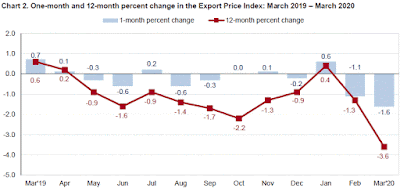Earlier this morning, the Labor Department's
Bureau of Labor Statistics released the
Consumer Price Index (CPI) for March 2020:
=========================================
Predicted: -0.3%
Actual: -0.4%
- Change From 12 Months Previous: +1.5%
=========================================
Below is the CPI when food and energy are removed, also known as
core CPI:
Predicted: +
0.1%
Actual: -0.1%
- Change From 12 Months Previous: +2.1%
=========================================
The above, yellow-highlighted figures represent the seasonally adjusted, month-to-month change in prices for a specific group of goods and services that consumers buy, and is, therefore, a
very important part of the overall inflation picture for the country.
The "predicted" figure is what economists were expecting, while the "actual" is the true or real figure.
General categories that constitute the CPI are:
- Healthcare
- Housing
- Clothing
- Communications
- Education
- Transportation
- Food and Beverages
- Recreation
- Miscellaneous Goods and Services (grooming expenses, etc.)
=========================================
From Today's Report:
"...The Consumer Price Index for All Urban Consumers (CPI-U) declined 0.4 percent in March on a seasonally adjusted basis, the largest monthly decline since January 2015, the U.S. Bureau of Labor Statistics reported today. Over the last 12 months, the all items index increased 1.5 percent before seasonal adjustment.
A sharp decline in the gasoline index was a major cause of the monthly decrease in the seasonally adjusted all items index, with decreases in the indexes for airline fares, lodging away from home, and apparel also contributing. The energy index fell 5.8 percent as the gasoline index decreased 10.5 percent. The food index rose in March, increasing 0.3 percent as the food at home index rose 0.5 percent.
The index for all items less food and energy fell 0.1 percent in March, its first monthly decline since January 2010. Along with the indexes for airline fares, lodging away from home, and apparel, the index for new vehicles declined in March. The index for shelter was unchanged, with increases in the indexes for rent and for owners’ equivalent rent offsetting the aforementioned decline in the index for lodging away from home. Indexes that increased in March include medical care, used cars and trucks, motor vehicle insurance, and education.
The all items index increased 1.5 percent for the 12 months ending March, a notably smaller increase than the 2.3-percent increase for the period ending February. The index for all items less food and energy rose 2.1 percent over the last 12 months. The food index rose 1.9 percent over the last 12 months, while the energy index declined 5.7 percent..."
=========================================
 |
| Chart: Consumer Price Index (CPI) - March 2020 Update |
=========================================
=========================================
Labels: consumer_price_index, consumers, cpi, disinflation, hard_data, inflation














